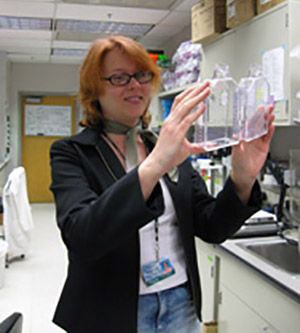 Dr. Belancio talks about DNA research
Dr. Belancio talks about DNA research
Ever wonder why cancer and certain other diseases affect mostly the elderly? Why cells can suddenly become 'bad' and lead to disease? How about why different people age differently? So does Dr. Victoria Belancio. She studies these questions on a very small scale, the size of your DNA.
Human retrotransposable elements are fragments of DNA that are present in our genomes in many copies because of their activity. The L1 element (Long interspersed element one), one such element, can change a cell in different ways. The L1 element can amplify by inserting a copy of itself into a new position within the DNA or can shuffle portions of DNA as it inserts elsewhere. "Since the mutagenesis is random these elements are known to cause a variety of human diseases, ranging from hemophilia to cancer depending on which gene they alter when they insert."
The current studies in Dr. Belancio's lab are aimed at understanding how L1 itself changes with aging and also how it can change the cell and the stability of its DNA due to age. In the lab they are able to study L1 elements by using assays in tissue culture, in which the L1 elements have a tag that generates a color when the L1 elements insert into the DNA.
Historically, the L1 elements are considered to be DNA parasites; they occupy a large portion of our DNA. There is still speculation on whether their origin is from retroviruses that integrated into our DNA because they share certain features with retroviruses. There are two schools of thought in the field, when it comes to L1 elements. Some researchers think that they have a function and that is why we have maintained them in our DNA, while others think that we cannot get rid of L1, causing our cells to have to coexist with them.
The old term 'Junk DNA' has new meaning to Dr. Belancio. Instead of being things that are inconsequential to normal cellular existence, L1 elements are now considered a burden with which cells have to deal. On the flipside, L1 elements at times can generate new genes with new functions. The question that she wants to help answer is how the cells balance the good, the bad, and the ugly associated with L1 expression.
"Can L1 be one of the contributors to natural aging and cancer in ways that have not been previously considered? We have reported L1 expression in normal human cells that were previously anticipated to suppress the L1-associated damage, so we also want to know how much of this damage is occurring and whether there is a difference between different cell types." Understanding how the L1 elements contribute to age-related diseases is our first goal. The long term aim is to identify means of preventing these diseases. "The more immediate goal is to understand what controls L1 and how it can contribute to cancer and aging. And then once we understand that, we can think of strategies to inhibit its activity."
